- Tyler Warren and Colston Loveland are worth the hype: Both tight ends score incredibly well in this model putting them on a TE1 trajectory in the near future.
- Harold Fannin Jr. is a worthwhile bet in rookie drafts: Even as a potential third-rounder, Fannin’s profile points to a tight end with high-end fantasy upside.
- 2025 NFL Draft season is here: Try PFF's best-in-class Mock Draft Simulator and learn about 2025's top prospects while trading and drafting for your favorite NFL team.
Estimated reading time: 9 minutes
NFL draft season is in full swing, which naturally comes with a plethora of ways to evaluate potential talent coming out of college with the potential to translate to the next level. This article series is no different, as we’ll add a fantasy football spin to the evaluation process to identify which incoming prospects have a shot to become fantasy-relevant early on in their NFL careers.
Next up is the tight end position for fantasy football, where this year’s class offers multiple first-round options and some intriguing Day 2 picks on top. To help sort through this year’s options, this model will account for the data and metrics that correlate best to NFL success for college prospects and utilize the key factors for each player to devise a prospect score. Like with any position, there is not one metric that will tell us whether a college prospect will be good or not in the NFL, but the purpose of this model is to combine the metrics and factors that data has proven to be the most relevant while providing weight to those that are more important than others.
For the tight end position, in no particular order, we’re looking at career receiving grades, yards per route run, athleticism, level of competition faced and draft capital, among a few others.
Keys:
- The prospect pool for this model consists of 111 past tight prospects dating back to 2019.
- 15 tight ends drafted since 2019 have become a top-12 PPR finisher for their position at least once (13.5%).
- 22 tight ends drafted since 2019 have become a top-24 PPR finisher for their position at least once (19.8%).
- 31 tight ends drafted since 2019 have become a top-36 PPR finisher for their position at least once (27.9%).
- This is an important context when understanding hit rates as many more prospects will not become fantasy-relevant than most given such a large pool of players.
- However, using this model, the higher the prospect score, the better the success rate will be for each prospect, as highlighted below.
- NOTE: Three tight ends being added to the top 95th percentile from this class has removed past top performers and slightly shaken up the hit rates within the 95th and 90th percentile.
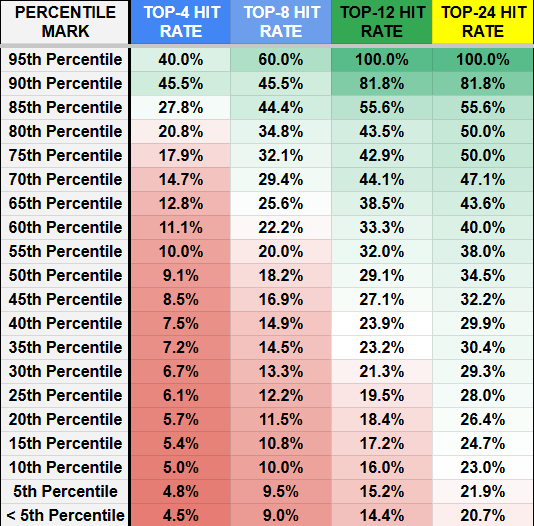
With all this in mind, it’s time to look at this year’s tight end prospects to identify our future fantasy football contributors. It should also be noted that these scores should not necessarily be used so much as your rankings as they should be more of a guide toward the quality of the player. Draft capital and landing spot can and will play a big part of actual rankings.
The 2025 Tight End Class
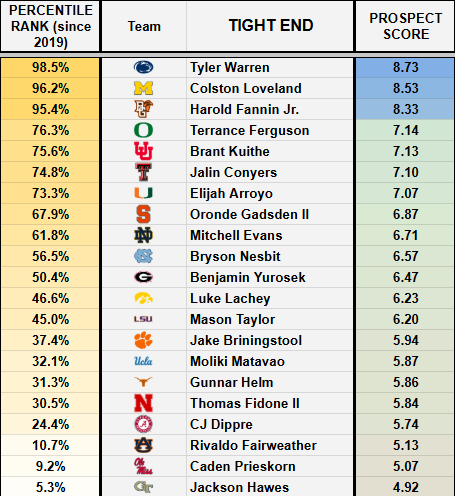
TYLER WARREN, PENN STATE
- Consensus Mock Draft capital: 12th overall

- Warren is set to be drafted as the top tight end in this year’s class, potentially in the top half of the first-round, which, considering his profile, makes perfect sense.
- Warren owns the third-highest prospect score in this model dating back to 2019, behind only Brock Bowers and Kyle Pitts, thanks to elite metrics across the board, which he mostly achieved in his final college season in 2024.
- Warren delivered 1,230 receiving yards, which ranked top-five among all Power-Five receivers while his 93.4 receiving grade led all receivers in 2024.
- Every tight end currently ranked among the top 95th percentile of tight end prospects in this model, going back to 2019, has already achieved at least one top-12 PPR fantasy finish in their NFL careers.
- The track record for tight ends to be drafted among the top 15 in the NFL draft is also strong, as Brock Bowers, Kyle Pitts, and T.J. Hockenson all have achieved at least one top-six PPR finish in their careers. Bowers, of course finished as TE1 overall in 2024.
- Warren's outlook is very strong, and even before we know the landing spot, fantasy managers should expect him to be a locked-in weekly fantasy starter much sooner rather than later.
COLSTON LOVELAND, MICHIGAN
- Consensus Mock Draft capital: 19th overall
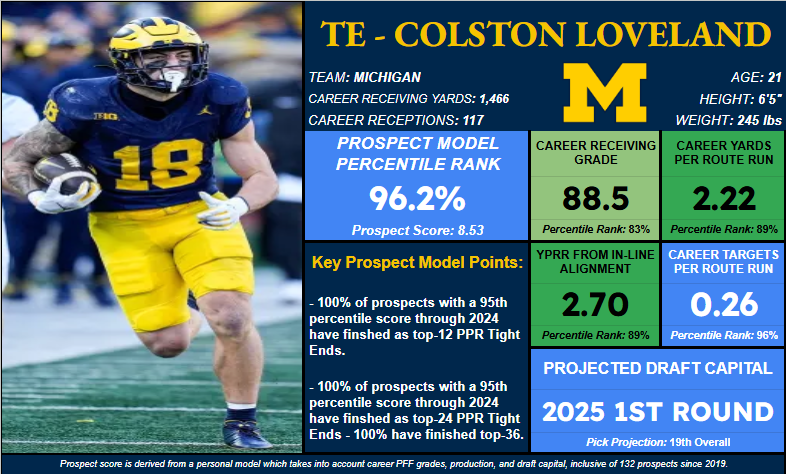
- Like the previously mentioned Warren, Loveland shares an excellent fantasy outlook because he joins this top percentile of past tight end prospects who have all found fantasy TE1 success in their careers.
- It wouldn’t be a surprise to see some talent evaluators put Loveland as the TE1 in this class, but for the most part, he is the clear TE2 behind Warren, and the model has him there as well.
- Loveland’s highs as a receiver in terms of production have never really come close to what Warren was able to do in 2024, although he did miss time this past season due to injury and looking at some of his rate stats – career YPRR, specifically – he was slightly better.
- That being said, Loveland boasts an overall elite prospect profile for the position regardless of missed time and as a latter-half of the first-round draft pick, he joins other past top-12 fantasy tight ends – Hayden Hurst and Dalton Kincaid along with the previous names mentioned when covering Warren, in addition to one top-24 finisher (Noah Fant) – in a great position to deliver weekly fantasy production.
MASON TAYLOR, LSU
- Consensus Mock Draft capital: 53rd overall
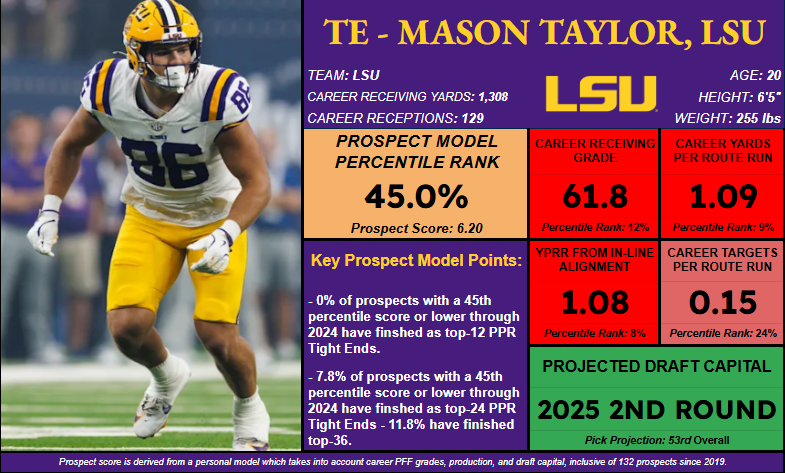
- Unlike Warren and Loveland, the consensus TE3 in this year’s class, Mason Taylor, does not offer an overly encouraging prospect profile, as there are a number of red flags that say he could take time to develop into the fantasy-relevant tight end we typically hope a second-round pick can be.
- For Taylor, his athleticism will be his greatest asset right now, and the hope is that he can develop into an all-around weapon who can be fantasy-relevant in the NFL, but it’s unlikely to happen right away, if at all.
- Unfortunately, the top-12 hit rate for tight end prospects scoring 45th percentile or lower in this model is non-existent.
- There are a few who scored 45th percentile or lower who have emerged as very deep-league options, but there is a clear limit to their ceiling as the best finish of the bunch was TE13 (2024 Cade Otton).
- There’s a first time for everything, and Taylor is young enough and could get the draft capital and landing spot where he works out for fantasy, but without both of those things, it’s hard to imagine spending a significant rookie pick on him in non-TE-premium leagues.
ELIJAH ARROYO, MIAMI (FL)
- Consensus Mock Draft capital: 57th overall
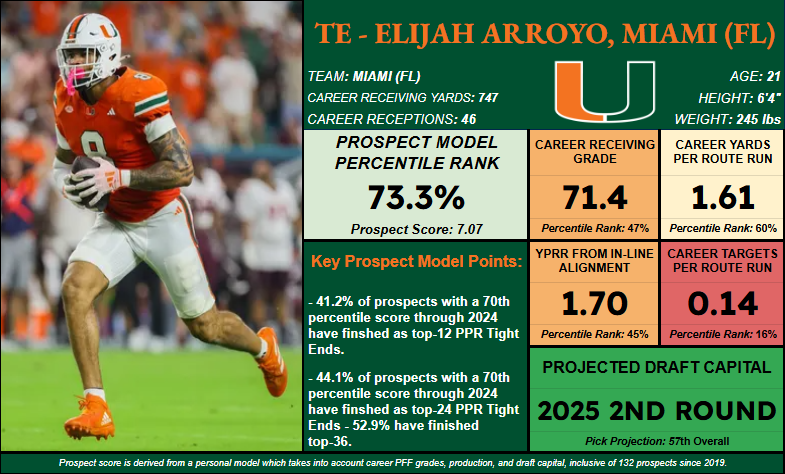
- Arroyo boasts a better profile and prospect score than the previously mentioned Taylor, although still nowhere close to Warren and Loveland, which puts him in a similar position as Taylor, where draft capital and landing spot are going to do a lot of the heavy lifting early in his career for him to become fantasy-relevant.
- Arroyo’s production for his college career comes almost entirely from his 2024 season, as he combined for his 11 receptions through his first three college seasons. Thanks to a strong final year, he is in consideration as a Day 2 pick, which helps his fantasy outlook a ton.
- Among 14 past Day 2 tight end prospects to score between the 70th and 90th percentile in this model, six have delivered top-12 fantasy finishes (42.9%), though there are plenty of similarly scored Day 2 players as Arroyo who have yet to even achieve a top-24 PPR finish, including Adam Trautman, Ben Sinnott (still early), Luke Schoonmaker, Greg Dulcich, Jace Sternberger, Darnell Washington and Luke Musgrave.
- There’s always going to be hope for these Day 2 tight ends thanks to guys like Tucker Kraft and Mark Andrews, but those are ultimately outliers more than anything, which has to be baked into rookie drafts when considering players like Arroyo, even in TE-premium formats.
HAROLD FANNIN JR., BOWLING GREEN
- Consensus Mock Draft capital: 66th overall
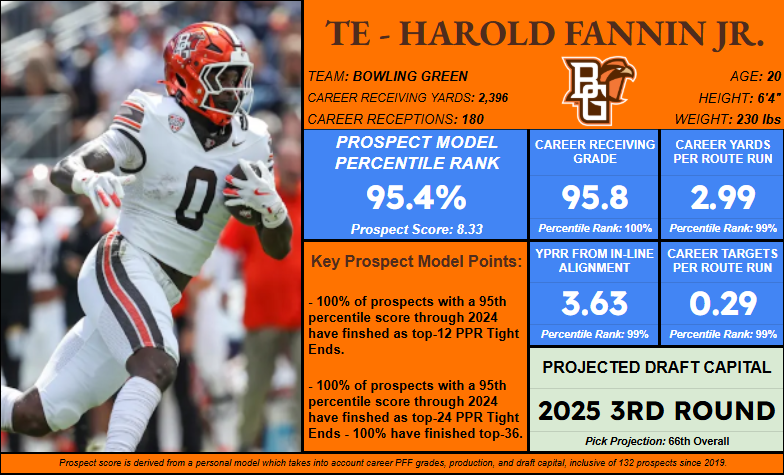
- Fannin Jr. is coming off the most productive college season ever for a tight end, producing 1,555 receiving yards, 10 receiving touchdowns and a 96.4 receiving grade – all of which led the entire FBS this past season.
- His career numbers in terms of receiving grade and yards per route run are no worse than the 99th percentile among the 132 past tight end prospects in this model dating back to 2019.
- Fannin's profile takes a hit in his expected draft capital (third round), overall athleticism (7.64 relative athletic score and level of competition because he spent his whole career in the Group of Five at Bowling Green.
- That being said, there are two high-end scorers in this model with similar concerns that have worked out to be elite fantasy tight ends – Trey McBride and Mark Andrews.
- McBride was a 91st percentile scorer in this model who spent his college career in the Group of Five, scored just an 8.03 RAS and was a Day 2 pick.
- Andrews was a Power Five tight end; however, he had a slightly worse RAS score (7.54) than Fannin and was selected even later (86th overall) than where he’s expected to go (66th).
- The NFL undoubtedly covets athleticism for the tight end position, and that is baked into this model, and even with a lower score, Fannin still profiles as elite thanks to his historic college production.
- It will be very interesting to see where he goes on draft day and how he’s valued by the NFL, but even in the worst-case scenario, rookie drafters should be willing to take a shot on him for the upside alone, potentially over both Arroyo and Taylor, when the time comes.



 © 2025 PFF - all rights reserved.
© 2025 PFF - all rights reserved.